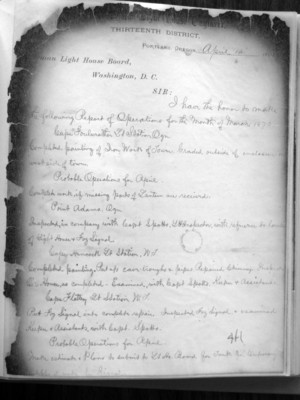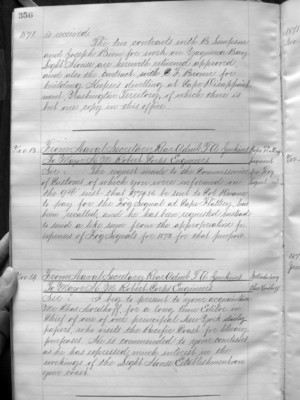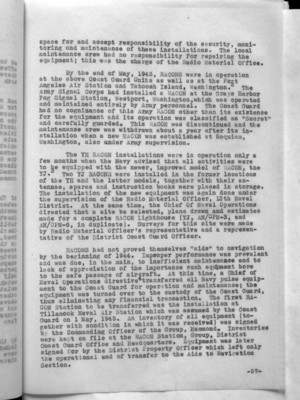Pages That Mention Fog Signal
1871-1872 keeper selection and LH building Vol. 336
49
Officice of Light House Engineer Thirteenth District Portland, Oregon April 14 1873
Chairman Light House Board, Washington, DC
Sir: I have the honor to make the following Report of Operations for the month of March 1873.
Cape Foulweather Lt Station, Ogn. Completed painting of Iron Work of Tower. Graded outside of enclosure on west side of tower.
Probable Operations for April Complete work, if missing parts of Lantern are received.
Point Adams, Ogn. Inspected, in company with Capt Spotts, LH Inspector, with reference to location of Light House & Fog Signal.
Cape Hancock Lt Station, W.T. Completed painting. Put up eave-troughs & pipes. Repaired chimney. Inspected Oil House as completed - Examined, with Capt. Spotts, Keeper & Assistants.
Cape Flattery Lt. Station, W.T. Put Fog Signal into complete repair. Inspected Fog Signal, & examined Keeper & Assistants, with Capt. Spotts.
Probable Operations for April. Make estimate & plans to submit to Lt. Ho. Board for tank for temporary ??? & water fog Signal.
1870-73 Lighthouse Board Annual Reports
25
1871.
is received.
The two contracts with B. Simpson and Joseph Bien for work on Yaquina Bay Light House are herewith returned approved and also the contract with C. F. Brown for building Keeper's dwelling at Cape Disappointment, Washington Territory, of which there is but one copy in this office.
Nov. 13.
From Naval Secretary Rear Adml. T. A. Jenkins To Major H. M. Robert Corps Engineers.
Sir:
The request made to the Commissioner of Customs of which you were informed on the 9th inst. that $774.86 be sent to Col. Duane to pay for the Fog Signal at Cape Flattery has been recalled, and he has been requested instead to send a like sum from the appropriation for expenses of Fog Signals for 1872 for that purpose.
Nov. 14.
From Naval Secretary Rear Adml. T. A. Jenkins. To Major H. M. Robert Corps Engineers.
Sir:
I beg to present to your acquaintance Mr. Chas Nordhoff, for a long time Editor in Chief of one of our principal New York daily papers, who visits the Pacific Coast for literary purposes. He is commended to your courtesies as he has expressed much interest in the workings of the Light House Establishment on your coast.
Coast Guard District narrative histories 1945
77
space for and accept responsibility of the security, monitoring and maintenance of these installations. The local maintenance crew had no responsibility for repairing the equipment; this was the charge of the Radio Material Office.
By the end of May, 1943, RACONS were in operation at the above Coast Guard Units as well as at the Port Angeles Air Station and Tatoosh Island, Washington. The Army Signal Corps had installed a RACON at the Grays Harbor Fog Signal Station, Westport, Washington, which was operated and maintained entirely by Army personnel. The Coast Guard had no cognizance of this Army RACON other than its existence for the equipment and its operation was classified as "Secret" and carefully guarded. This RACON was discontinued and the maintenance crew was withdrawn about a year after its installation when a new RACON was established at Hoquiam, Washington, also under Army supervision.
The YH RACON installations were in operation only a few months when the Navy advised that all activities were to be equipped with the newer, improved model of RACON, the YJ.³ Two YJ RACONS were installed in the former locations of the YH and the latter models, together with their antennae, spares and instruction books were placed in storage. The installation of the new equipment was again done under the supervision of the Radio Material Officer, 13th Naval District. At the same time, the Chief Of Naval Operations directed that a site be selected, plans drawn and estimates made for a complete RACON Lighthouse (YJ, AN/CPN-3, and AN/CPN-6, in duplicate). Surveys for this site were made by Radio Material Officer's representative and a representative of the District Coast Guard Officer.
RACONS had not proved themselves "aids" to navigation by the beginning of 1944. Improper performance was prevalent and was due, in the main, to inefficient maintenance and to lack of appreciation of the importance such equipment bore to the safe passage of aircraft. At this time, a Chief of Naval Operations directive^4 transferred all Navy pulse equipment to the Coast Guard for operation and maintenance; the equipment was turned over to the custody of the Coast Guard, thus eliminating any financial transaction. The first RACON Station to be transferred was the installation at Tillamook Naval Air Station which was assumed by the Coast Guard on 1 May, 1945. An inventory of all equipment (together with condition in which it was received) was signed by the Commanding Officer of the Group, Hammond. Inventories were kept on file at the RACON Station, Group, District Coast Guard Office and Headquarters. Equipment was later signed for by the District Property Officer which left only the operational end of transfer to the Aids to Navigation Section.
-57-


